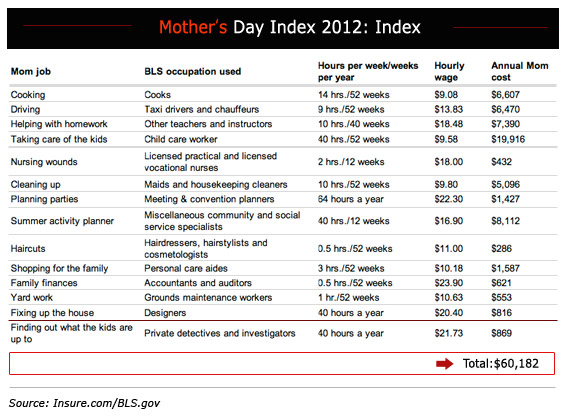This Mother’s Day, go ahead and tell your mom how much you value her―just don’t try to back it up with numbers. New survey data shows a decline in the economic value of mothers' work.
If a stay-at-home mom was ever handed a pink slip, dad would have to hire a nanny, a driver, a cook, a janitor, a psychologist, a laundry-machine operator, and a myriad of other professionals for the odd jobs moms do on a daily basis. A Salary.com calculation found that after all the various duties are added up, stay-at-home moms put in 94.7 hours in a typical workweek, and it would cost $112,962 a year to replace her. For working moms, the extra 57.9 hours a week of work they put in is worth $66,979.
RELATED: How the Pill Drives Economic Growth
Though that’s a hefty salary mom should be making, $113K is actually much lower than five years ago. In 2007, Salary.com calculated that mom’s work was worth $138,094 a year.
Another study by Insure.com found a similar drop, though they place a much lower value on the work of mom to start with. They calculated that the informal work mom does is worth $60,182 a year, down from $61,436 last year, a 2 percent drop. In 2003, mothers' work was worth $64,593 a year in 2012 dollars.
The recent recession and rising dependence on two incomes have caused many women to feel that taking care of children full time is a luxury they can’t afford.
The main reason for the drop is that the professions that could potentially replace mom have seen pay cuts as well, but it also comes at time when many mothers feel the value of their work is being questioned. Ann Romney took flack for being a stay-at-home mom last month from Democratic strategist Hilary Rosen, who said Mrs. Romney had never worked a day in her life. Though many women, including Michelle Obama, were quick to throw their support behind Ann Romney and other stay-at-home moms, the recent recession and rising dependence on two incomes have caused many women to feel that taking care of children full time is a luxury they can’t afford.

In 2010, there were 5 million stay-at-home mothers in the U.S., down from 5.6 million in 2007. One reason―many women choose to remain in the workforce during the recession. That’s also a nearly 50 percent drop from the 9.8 million stay-at-home moms in 1969 (though dads did help pick up the slack: there were 154,000 stay-at-home dads in 2010). Stay-at-home moms also don’t typically live in luxury: they tend to be less educated than working moms and have lower household incomes.
According to a recent Pew Research Center report, 73 percent of Americans say having more women in the workforce has been a positive change. But when the effects on children were added to the question, only 21 percent of Americans said the increase in mothers with young children working has been a positive change for society, while 37 percent said it’s been negative.
RELATED: Rich Baby, Poor Baby: Overspending on Kids Is a Waste
At the same time, for working mothers, the cost of paying someone else to take care of their children is skyrocketing. In many states, like Connecticut, Minnesota and New York, the annual cost of day care for young children exceeds the cost of college tuition and board.
In the most expensive state―Massachusetts―day care sets parents back $19,000 a year on average. If a woman earns the median salary of $36,931 for women working full time in the U.S., those costs can take up half her annual pay.
So regardless of whether the value of a mom’s work has fallen in this economy, her sacrifices certainly haven’t.





